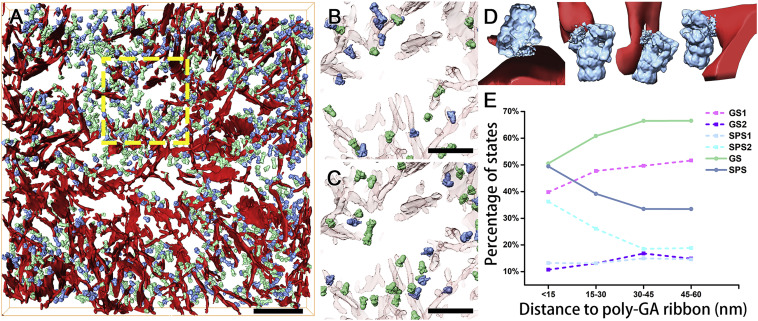In Situ Structure of Neuronal C9orf72 Poly-GA Aggregates Reveals Proteasome Recruitment
Qiang Guo, Carina Lehmer, Antonio Martinez-Sanchez, Till Rudack, Florian Beck, Hannelore Hartmann, Manuela Perez-Berlanga, Frederic Frottin, Mark S.Hipp, F. Ulrich Hartl, Dieter Edbauer, Wolfgang Baumeister, Ruben Fernandez-Busnadiego - Department of Molecular Structural Biology, Max Planck Institute of Biochemistry, Martinsried, Germany; German Center for Neurodegenerative Diseases (DZNE), Munich, Germany; Munich Cluster for Systems Neurology (SyNergy), Munich, Germany; Department of Biophysics, Ruhr University Bochum, Bochum, Germany; NIH Center for Macromolecular Modeling and Bioinformatics, Beckman Institute for Advanced Science and Technology, University of Illinois at Urbana-Champaign, Champaign, USA; Department of Cellular Biochemistry, Max Planck Institute of Biochemistry, Martinsried, Germany; Ludwig-Maximilians University Munich, Munich, Germany.
![In Situ Structure of Neuronal C9orf72 Poly-GA Aggregates Reveals Proteasome Recruitment]()
Protein aggregation and dysfunction of the ubiquitin-proteasome system are hallmarks of many neurodegenerative diseases. Here, we address the elusive link between these phenomena by employing cryo-electron tomography to dissect the molecular architecture of protein aggregates within intact neurons at high resolution. We focus on the poly-Gly-Ala (poly-GA) aggregates resulting from aberrant translation of an expanded GGGGCC repeat in C9orf72, the most common genetic cause of amyotrophic lateral sclerosis and frontotemporal dementia. (…) poly-GA aggregates may compromise neuronal proteostasis by driving the accumulation and functional impairment of a large fraction of cellular proteasomes.
